 Clemson University in Clemson, SC, will present the Clemson University Department of Art Faculty Exhibit, featuring works by the Clemson University faculty, Oct. 5 – Nov. 12. Guests are invited to interact with the exhibiting artists and hear about the work during the Artist Talk to take place Oct. 8, at 2:30 p.m. and Oct. 28, at 11 a.m. An exhibit reception will be held on Oct. 8, 6–8pm in the Center for Visual Arts – Lee Gallery, 1–101 Lee Hall.
Clemson University in Clemson, SC, will present the Clemson University Department of Art Faculty Exhibit, featuring works by the Clemson University faculty, Oct. 5 – Nov. 12. Guests are invited to interact with the exhibiting artists and hear about the work during the Artist Talk to take place Oct. 8, at 2:30 p.m. and Oct. 28, at 11 a.m. An exhibit reception will be held on Oct. 8, 6–8pm in the Center for Visual Arts – Lee Gallery, 1–101 Lee Hall.
The participating artists include: printmaker Todd Anderson, sculptor David Detrich, digital media artist David Donar, sculptor Joey Manson, painter Todd McDonald, digital media artist Christina Nguyen Hung, sculptor Greg Shelnutt, functional ceramicist Denise Woodward-Detrich, photographer Anderson Wrangle, drawer Kathleen Thum, and sculptural ceramicist Valerie Zimany.
Relationships dominate our human experience. These experiences shape us into who we are as individuals and how we interact with the rest of our environment as a society. This existence between ourselves and our environment is a constant balancing act of impacting and being impacted by the vast conglomeration of experiences.
Having the faculty’s work accessible in the gallery adds a new dimension to the teaching environment at Clemson University, allowing students and visitors to see into the thoughts of the artists. In this exhibition, the work prompts questions to the viewer of human engagement in natural, societal, and personal environments.
The work of David Donar, Kathleen Thum, Todd Anderson, and Joey Manson turn our view outward into the natural world. David Donar uses a mixture of traditional and new media to explore the landscape before human influence. In his film, he looks at Lake Ouentironk, also known as Lake Simcoe, a fresh water lake north of Toronto, Ontario. Through the use of watercolor painting he creates “vibrant and moving picture to capture the various seasons as well as the fluid changes of water, land, and sky” to render for the viewer an area as it was over four-hundred years ago.
Interested in the human species’ relationship to the earth, Kathleen Thum examines complex relationships between nature and humans through the use of intricate line. The tubules are given a life of their own as she examines how they might be affected by pressure, gravity, fluids, and gases. In her current work, she specifically examines the relationship a species has with its environment, and how environmental changes cause species to flourish or perish. In the case of the relationship humans have with Earth’s natural resources, she asks: “Are we, as a human species, at our maximum Carrying Capacity in regards to the earth’s natural resources?”
Through the work of Todd Anderson, the viewer is challenged to make a connection between themselves as part of the human population and the greater environment. Where Thum studies natural resources, Anderson makes a study of human impact on the environment by documenting the retreating glaciers of Waterton-Glacier International Peace Park in Alberta, Canada and Montana, US. Over the course of his documentation he has seen 25 glaciers reduced to 18 since 2010. Expected to disappear by 2020, Anderson seeks to use his field data of sketches, watercolors, and photographs to create original fine art woodblock prints. He hopes The Last Glacier “will serve as a historical record of this momentous time of change within the park and offer unique insights into the larger issue of climate change”.
Joey Manson works with industrial materials to make large scale sculptures that embody organic qualities. These abstracted representations of our present environments, technological and natural, become “an exploration of our built, social, and environmental constructs”, says Manson.
Following is an examination of our social environment by Valerie Zimany, Greg Shelnutt, Anderson Wrangle, and David Detrich. With the use of sculpture and ceramics, they pull apart and clash together cultural elements.
Valerie Zimany’s bright colors and imagery clash on the softer surfaces of her ceramic sculptures, where she uses these “forced relationships” to “question compatibility.” After graduating with a BFA from the University of the Arts, Philadelphia, PA, Zimany went on to study at Kanazawa College of Art as a “Fellow” in Kanazawa, Japan. With a foot in these two backgrounds, Zimany uses her work to study how these cultures intersect. “In my current work,” she says, “I visually examine complex relationships between the East and West, nature and technology, and intimate and public worlds.”
The work of Greg Shelnutt has a narrative quality inviting the viewer to “question accepted notions about culture.” His use of materials such as metal and wood give a rustic quality and depth to his work. The storytelling these objects provide shifts between subtlety or forwardness. He couples recognizable objects in American culture with strong phrases, sparking conversation with his viewers. “As an academic artist living in South Carolina,” he says, “–I feel that part of my obligation to the profession is to engage with the broad public.”
Similarly, Anderson Wrangle uses black and white photography to document a moment that will forever impact our history.
David Detrich describes what drives his work as “paradoxical tensions that are created when oppositions find a common ground.” Using color wheels and swatch groups, he creates an interesting narrative of color and poetry. Detrich asks, “How is aesthetic taste derived?” Is it experienced intuitively or learned by an external force? Contrasting commercial design with high art practices, the viewer is invited to discover what drives their taste.
Todd McDonald, Denise WoodwardDetrich, and Christina Nguyen-Hung turn the viewers attention from the outside world of nature and culture, and into the more intimate realm of home and self.
Through his vibrant paintings, Todd McDonald explores how humans perceive their environment and how this perception has evolved to include digital media as a lens. He catalogues the change in perception through painting, one of the original lenses for which humans recorded their environment. McDonald says, “As methods of image making evolve we are confronted with new visual qualities that affect the way we see and consequently create models of ‘our world’.”
Fascinated with the idea of utility, Denise Woodward-Detrich investigates the interaction between functional objects and our day-to-day activities. In a study of balance, her beautifully glazed ceramics take on interesting shapes as they equally embody functional, visual, and tactile intrigue.
Christina Nguyen-Hung zooms the scope of her study to microscopic levels. As an interdisciplinary artist who combines electronic and biological media, she is interested in thinking about “material relationships between the individual (human body) and its environment in new ways.” To explore these relationships, Nguyen-Hung uses a common chicken egg and its mutable properties to study how common household items can transform the egg through what she describes as “little kitchen science.”
Lee Gallery hours are 9 a.m.-4:30 p.m. Monday-Thursday.
The exhibition, artist talks and reception are free to the public because of the generous support given to the Center for Visual Arts.
END
About the Center for Visual Arts
The Center for Visual Arts (CVA) at Clemson University is where students, visitors and scholars explore contemporary perspectives in art and culture through research, outreach programming and studio practice. With a mission to engage and render visible the creative process, the CVA is a dynamic intellectual and physical environment where art is created, exhibited and interpreted. It educates through academic research and practice with art at its core, drawing upon varied disciplines to examine critically cultural issues and artistic concerns.


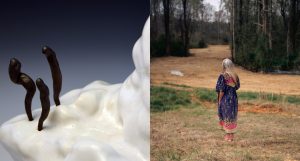 CLEMSON – “
CLEMSON – “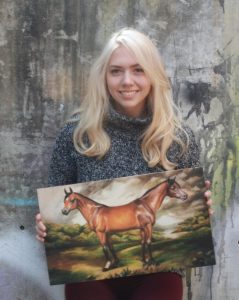 Since October is a popular month for visual arts undergraduate students to begin researching and applying for graduate schools, I’d like to share some reflections from current MFA sculpture candidate, Kimberly Day as to why she chose Clemson University over a big city school.
Since October is a popular month for visual arts undergraduate students to begin researching and applying for graduate schools, I’d like to share some reflections from current MFA sculpture candidate, Kimberly Day as to why she chose Clemson University over a big city school.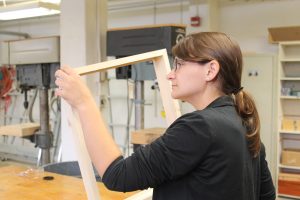 The Center for Visual Arts – Lee Gallery at Clemson University is known to be a catalyst for showcasing the research of art students, faculty, national and international artists. What is not commonly known is that it also offers an internship opportunities to Bachelor of Fine Arts (BFA) students. The program is run by the gallery director, Denise Woodward-Detrich. Student interns gain hands on experience and professional development by working on real life projects. Students also receive custom course credit based on hours not to mention valuable experience to put on their resume.
The Center for Visual Arts – Lee Gallery at Clemson University is known to be a catalyst for showcasing the research of art students, faculty, national and international artists. What is not commonly known is that it also offers an internship opportunities to Bachelor of Fine Arts (BFA) students. The program is run by the gallery director, Denise Woodward-Detrich. Student interns gain hands on experience and professional development by working on real life projects. Students also receive custom course credit based on hours not to mention valuable experience to put on their resume.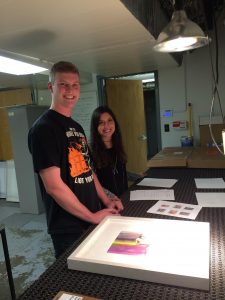 Interns, Hannah Cartee and Leah Brazell developed and delivered a gallery talk with interactive activities to almost 50 middle school students. Activities took place at a permanent art installation in Hardin Hall and at MFA alumnus, Richard Lou’s, Stories On My Back installation in the Lee Gallery. Additional projects include introducing visiting artist, Richard Lou at his artist talk and writing an article for the Master of Fine Arts (MFA) thesis exhibition, Solastalgia, which is scheduled to open in the Lee Gallery later this month on Monday, Oct, 31.
Interns, Hannah Cartee and Leah Brazell developed and delivered a gallery talk with interactive activities to almost 50 middle school students. Activities took place at a permanent art installation in Hardin Hall and at MFA alumnus, Richard Lou’s, Stories On My Back installation in the Lee Gallery. Additional projects include introducing visiting artist, Richard Lou at his artist talk and writing an article for the Master of Fine Arts (MFA) thesis exhibition, Solastalgia, which is scheduled to open in the Lee Gallery later this month on Monday, Oct, 31.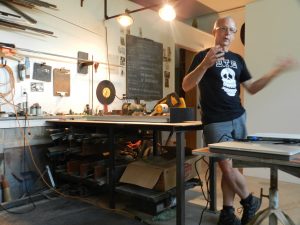 Earlier this month, Center for Visual Arts-Lee Gallery at Clemson University interns visited the studio of sculpture professor and the Master of Fine Arts (MFA) graduate program coordinator, Dave Detrich. All of the art department professors are not only teachers, but they are working artists. Interns were able to view his sculpture in person and they had an opportunity to ask him questions. Here is a summarized account of his answers.
Earlier this month, Center for Visual Arts-Lee Gallery at Clemson University interns visited the studio of sculpture professor and the Master of Fine Arts (MFA) graduate program coordinator, Dave Detrich. All of the art department professors are not only teachers, but they are working artists. Interns were able to view his sculpture in person and they had an opportunity to ask him questions. Here is a summarized account of his answers.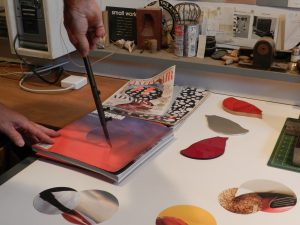 Is there a reason you have been using wall sculpture versus sculpture in the round in your current work?
Is there a reason you have been using wall sculpture versus sculpture in the round in your current work?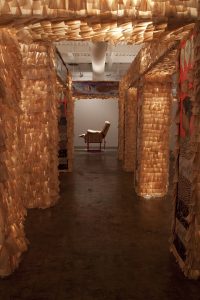
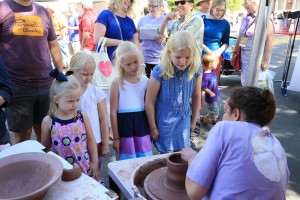
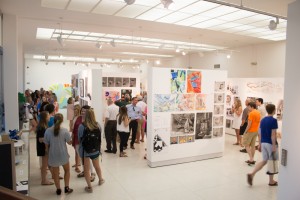 As the spring semester came to a close, Art Foundations students at Clemson University installed pieces in the
As the spring semester came to a close, Art Foundations students at Clemson University installed pieces in the 


 and individual sponsors made this event possible:
and individual sponsors made this event possible:


